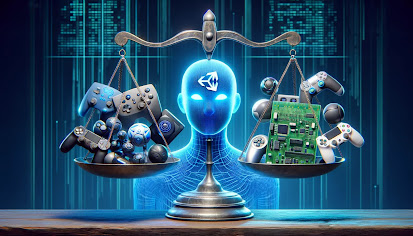In the rapidly evolving landscape of multiplayer video gaming,
fairness and game balance are paramount to ensuring a satisfying
experience for players of all skill levels. Leveraging Artificial
Intelligence (AI) within Unity, one of the leading game development
platforms, presents innovative opportunities to enhance game
balancing and ensure fair play. This integration is particularly
significant as AI gaming companies continue to push the
boundaries of what's possible in game dynamics, and as
hire unity game developers for hire seek to implement
these advanced technologies in their projects.
Understanding Game Balance and Fair Play
Game balance in multiplayer games refers to the design of player
interactions and game mechanics that are equitable and provide
equal opportunities for success. Fair play, on the other hand,
ensures that no player has an undue advantage over others,
and that all actions within the game environment adhere to a
set of established rules that all players respect.
The Role of AI in Enhancing Game Balance
AI can dynamically adjust game parameters based on real-time
data analysis, ensuring that all players, regardless of their skill
level, have a competitive and enjoyable experience. Here are
some ways AI is utilized to maintain balance and fair play:
Difficulty Adjustment:
AI algorithms can analyze player performance and adjust the
difficulty level of the game in real-time. For instance, if a player
is dominating the game, the AI can enhance the capabilities
of other players to level the playing field, or conversely, reduce
the challenge faced by a player who is struggling.
Detecting and Managing Cheating:
AI-driven systems can monitor player actions to detect patterns
indicative of cheating, such as aimbots or speed hacks. Once
identified, the game can take automatic measures to either warn
the player or limit their abilities to maintain fairness.
Matchmaking Systems:
AI algorithms are crucial in matchmaking systems, where they
analyze player data to match players of similar skill levels,
ensuring that games are competitive and balanced. This not
only improves the user experience but also retains player
engagement over longer periods.
AI Gaming Companies and Their Contributions
AI gaming companies are at the forefront of developing sophisticated
AI solutions that integrate seamlessly with Unity games. These
companies specialize in creating algorithms that adapt to player
behaviors, enhancing the gaming experience by making it more
engaging and fair. By employing complex data analysis and machine
learning models, these companies help developers anticipate player
needs and respond to them in real time.
Hiring Unity Game Developers for AI Integration
For game studios looking to incorporate advanced AI into their multiplayer
games, hiring skilled Unity game developers is a crucial step. These
developers not only bring expertise in Unity’s development environment
but also have the capacity to integrate AI technologies effectively.
Unity game developers for hire often work closely with AI specialists
to tailor AI systems that meet specific game requirements, ensuring
that the game remains balanced and fair for all players.
Challenges and Considerations
While AI can significantly enhance game balance and fairness, it also
presents challenges, such as ensuring that the AI itself does not
become too controlling or detract from the game’s fun. Developers
must carefully design AI systems that support the game's design and
user experience without overwhelming it.
Conclusion
The use of AI in multiplayer Unity games is transforming how developers
approach game balance and fair play. As AI gaming companies continue
to innovate, and as more Unity game developers for hire integrate these
technologies, the potential for creating balanced, fair, and engaging
multiplayer games is boundless. The key to success lies in leveraging
AI not just as a tool for enforcement, but as a dynamic support system
that enhances the overall gaming experience.
Read more blogs about the gaming industry:
The Evolution of Animation: From traditional 2D to modern 3D techniques
The Future of Animation: Emerging trends in 2D and 3D animation industries
Storyboarding for Animation: Techniques applicable in both 2D and 3D storyboarding.

.jpg)


No comments:
Post a Comment